Top > International Patients > Diagnostic Testing
Diagnostic Testing
Testing
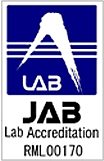
The Department of Clinical Laboratory of the University of Tokyo Hospital accredited under ISO 15189 as a clinical laboratory
ISO 15189 is an international accreditation for fulfilling specific requirements concerning quality and competence as a clinical laboratory. The test results reported by our clinical laboratory are quality-guaranteed as that of a world-class clinical test. We believe that the spread of laboratories accredited under ISO 15189 will contribute to the standardization of clinical laboratory tests in Japan and benefit both the clinicians who order the tests, and patients who are examined and treated in accordance with the test results.
Furthermore, the Department of Clinical Laboratory makes various efforts, such as improving patient amenities, reducing outpatients' time to wait for blood collection, installing a suggestion box at the blood collection room, and providing substantial information over the website. The physiological laboratory also strives to provide high quality test results at all times in accordance with the purport of ISO.
-
Collection and examination of samples, such as blood, urine, stool, and sputum
-
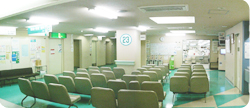
The Blood/Urine Collection Counter (Counter No.23 on the second floor) of the Department of Clinical Laboratory is open from 8:10 AM to 4:30 PM. We will hand out reception numbers (with names) and will guide the patients in order.
The blood collection room was expanded to shorten waiting.
* If the waiting time after the reception is long, you may leave to receive other examinations beforehand. If so, please leave a message to the hospital staff.
* If you have brought a sample (such as urine, stool, and sputum), please place at counter.
* If you are to undergo urinalysis, you will be given a paper cup. Collect your urine sample at the urine collection room and place it counter.
Notes Blood Collection
Blood will be collected mainly from the arm, so do not wear tight-sleeved clothes. Wear clothes that allow you to easily expose your upper arms above the elbow joint.
Please cooperate with identity verification and follow the instructions of the hospital staff.
If any of the following applies to you, please report to the hospital staff.
- Do you feel sick during blood collection?
- Are you allergic to any disinfectant or glove (such as latex)?
- Are you undergoing hemodialysis? Are you securing blood vessels for shunts?
- Have you had your breast surgically removed?
- Do you have any inquiry, request, or uncertainty about the blood collection?
For inquiries about the diagnostic result and check items, please consult your doctor.
Blood is collected mainly from the right or left upper arm. However, if it is difficult to do so, we may collect blood from other parts of the body, such as the back of the hand.
After collecting blood, adhesive tape is applied to stop the bleeding. Apply pressure without massaging until bleeding stops (approximately 3 to 5 minutes).
Even after bleeding stops, you may bleed again through an action such as carrying heavy items.
 Blood Collection; Guidelines for Patients [PDF: 122KB]
Blood Collection; Guidelines for Patients [PDF: 122KB]
 Notes on Blood Collection [PDF: 116KB]
Notes on Blood Collection [PDF: 116KB]
The blood collection room was expanded with more blood collection tables.
We also strive to improve patient amenities and reduce time waiting for blood collection.
Notes Urine/stool test
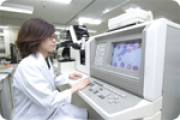
For urine collection, please collect the middle portion of the urine instead of the initial or last portion.
For details about the stool test procedure, see the explanatory note attached to the sample bottle in the specified bag.
-
Bleeding time test
-
In this test, the skin (on the earlobe) is slightly cut and the time it takes until bleeding ceases naturally is measured.
-
Glucose tolerance test
-
This test is designed to assess the function to metabolize glucose by the degree of rise in the blood glucose level after ingesting glucose. First, the blood sample is taken from the patient with an empty stomach early in the morning. Then, the patient ingests glucose and the blood and urine is collected after the prescribed time for the test.
(Time required: approx. 2 to 3 hours)
Notes
- Reception hours are from 8:10 AM to 9:30 AM. Please be punctual.
- Do not eat or drink (except for clear fluid) from after 9:00 PM on the previous day until the test is over. (Otherwise, you cannot receive the test.)
- During the tolerance test, stay in a resting state.
(Moving excessively may affect the blood glucose level and hinder accurate measurement.)
- The test is conducted according to your doctor's instructions (such as the frequency to collect blood).
If you are on medication, consult your doctor in advance.
-
Electrocardiography
-
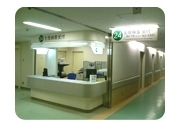
Electrodes are attached to the patient's wrists, ankles, and chest while lying on a bed. The slight electrical signals produced when the heart beats are detected. This makes it possible to obtain cardiac data (such as the presence of irregular pulses and cardiac infarction) in a short time. It does not produce any pain or irritation except for slight coolness of electrodes.
Notes
Wear clothes that allow you to easily expose waist.
-
Ankle brachial pressure index (ABPI) and pulse wave velocity (PWV) measurement
-
Cuffs for blood-pressure measurement are put on the arms and legs of the patient lying on the back. By measuring the pulse wave velocity and ankle brachial pressure index, vascular hardness and presence of stenosis and blockage in an artery can be checked.
Notes
Wear clothes that allow you to easily expose upper arms and legs (from knees to heels).
-
Treadmill test (exercise electrocardiography)
-
The patient's ECG and blood pressure are monitored while the patient walks on the treadmill, to observe the changes in the ECG and blood pressure during an exercise. This test is designed to detect ischemic heart diseases and assess the functional capacity.
Notes
If you are on medication, consult your doctor on the day of the test.
-
Long-term Holter ECG monitoring
-
The ECG of the patient in daily life is monitored over a period of 24 hours using an ambulatory ECG monitor.
This test is designed to detect irregular pulses and assess the therapeutic effect of medicines and the relationship between subjective and objective symptoms.
Notes
- Do not take bath or shower while carrying the monitoring device.
- Report subjective symptoms noticed when carrying the monitoring device.
- The patient must also visit the hospital on the next day to have the monitoring device removed.
-
Long-term ambulatory blood pressure monitoring (ABPM)
-
A long-term blood pressure and ECG are monitored and recorded using an ambulatory blood pressure monitor and ECG monitor.
This test is designed to monitor changes of blood pressure in daily life and therapeutic effects of medicines.
Notes
- Wear clothes with loose sleeves to put on cuffs on the arms for monitoring blood pressure.
- Do not take bath or shower while carrying the monitoring device.
- The patient must also visit the hospital on the next day to have the monitoring device removed.
-
Echocardiography
-
Transthoracic echocardiography is designed to assess the movement and size of the heart from the body surface and detect problems, such as valvular regurgitation.
The time required for the test is approximately 30 minutes.
Transesophageal echocardiography is designed to observe the heart from the gullet by endoscopic examination.
Notes
Be punctual to the reservation time.
Do not eat or drink four hours prior to the transesophageal echocardiography. (No dietary restriction for transthoracic echocardiography.)
Both tests require exposing the upper half of the body and ankles, please wear clothes that are easy to expose.
Robes for female patients are available.
-
Endovascular echography
-
This test is designed to check the conditions of carotid and renal arteries and veins in the limbs from the body surface.
Notes
- Wear clothes that are easy to take off and put on.
- Do not eat anything in the morning for a test in the morning, and do not eat anything for lunch for a test in the afternoon.
Example: For the morning test reservation, do not eat breakfast. For afternoon test reservation, do not eat lunch.
-
Abdominal echography
-
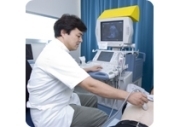
This test is designed to check the condition of abdominal organs (liver, gallbladder, pancreas, spleen, and kidney).
The time required for the test is approximately 10 to 20 minutes, but it may vary depending on the test items. The test does not cause any pain.
Notes
Do not eat anything in the morning before the test in the morning. When receiving a test in the afternoon, have a light breakfast in the morning and do not eat anything for lunch.
You may drink tea or water for taking medication. Wear clothes that allow you to expose your abdomen.
-
Urology echography
-
This test is designed to check the conditions of pelvic viscera (kidney, bladder, the prostate, ureter, and testis).
The time required for the test is approximately 5 to 10 minutes, but it may vary depending on the test items. The test does not cause any pain.
Notes
Refrain from urinating until the reservation time.
If you also undergo the urine test, receive the urology echocardiography first.
-
Thyroid echography
-
This test is designed to check the condition of the thyroid.
The time required for the test is approximately 10 to 20 minutes, but it may vary depending on the test items. The test does not cause any pain.
Notes
Your neck will be monitored, so wear clothes that allow you to expose your neck easily.
-
Respiratory function test
-
In this test, the size of the lung when it is filled (lung capacity) and condition of the airway are checked.
The time required for the test depends on the type of the test (10 to 30 minutes).
This test is designed for the diagnosis of asthma and chronic obstructive pulmonary disease (COPD) and assessment of the lung function before and after a surgery.
Notes
This requires the patient's effort and cooperation for accurate assessment.
The patient must breathe in deeply and breathe out the air with great force in time with the calls.
-
Sleep apnea test
-
In this test, the patient takes the monitoring device home to monitor the patient's respiratory condition while sleeping at night.
Notes
- On the day to take the monitoring device home, visit Counter No. 24 before the reservation time.
- An explanation will be provided on how to carry and use the monitoring device (approx. 30 minutes).
- Be sure to return the monitoring device to the clinical laboratory before 10:00 AM on the next day.
-
SpO2 monitoring
-
This test is designed to monitor arterial oxygen saturation (SpO2) in the body by attaching a sensor to a fingertip over a period of 24 hours.
Notes
- Report incidents, such as the occasions when you lose your breath and your hours of sleep.
- On the day of reservation, visit Counter No.24 before the reservation time.
- A sensor will be attached to your fingertip and the monitor will be attached for you to carry on your waist (approx. 15 minutes).
- This test requires monitoring over 24 hours, so visit the respiratory function test room on the same time on the following day to have the sensor removed.
-
Nerve conduction, evoked potential, and magnetic stimulation test
-
This test is designed to check the patient's speed and responses by providing electrical or magnetic stimuli to the nerve from the body surface as well as sonic and visual stimuli and analyzing the muscle movement and electric potentials on the scalp.
The time required for the test is approximately 60 minutes. This test is effective for the diagnosis of sensory and motor disturbances. The electric stimulation produced for the test may cause some pain.
Notes
Wear loose clothes that allow you to expose your upper arms above elbows and legs above the knee.
-
Needle electromyography
-
This test is designed to record the electric potential from muscle fibers by inserting needle electrodes into the muscle. It is effective for the diagnosis of muscular and neurological disorders. It requires sticking needles and produces some pain. The time required for the test is usually approximately 60 minutes.
Notes
Wear loose clothes that allow you to expose your upper arms above elbows and legs above the knee.
-
Electroencephalography
-
In the brain, nerve cells transmit information to each other by electric signals at all times whether we are awake and thinking or asleep. Electroencephalograms are designed to monitor such activities in the form of waveforms by detecting electrical changes from the scalp. The time required for the test is usually approximately 60 minutes.
Notes
Wash and keep your hair clean before you visit the hospital on the day you receive the test.
The patient receiving sleep electroencephalography must regulate his/her hours of sleep to naturally fall asleep during the test.
-
Magnetoencephalography
-
This test is designed to record the electrical activity in the brain by high-sensitivity magnetic sensors. The time required for the test is usually approximately 60 minutes. This test is designed to detect the sensory and speech areas and functions related to irregular activities causing disorders.
Notes
Wash and keep your hair clean without applying makeup before you visit the hospital on the day you receive the test. Metal objects attached to the body will interfere with the test. The test may not be conducted if any of the following devices are attached to the body: metal accessories, braces, aneurysm clips, cochlear implant, artificial joint, and cardiac pacemaker.
-
Optical topography test
-
In this test, optical sensors are used to monitor the changes of cerebral blood flow caused by cerebral activities. The time required for the test is usually approximately 30 minutes. This test is designed to detect the sensory and speech areas and functions related to irregular activities causing disorders.
Notes
Wash and keep your hair clean without applying makeup before you visit the hospital on the day you receive the test. Metal objects attached to the body will interfere with the test. They must be removed before the test. The test may not be conducted if any of the following devices are attached to the body: braces, aneurysm clips, cochlear implant, artificial joint, and cardiac pacemaker.
-
Thermography test
-
In this test, infrared cameras are used to photograph the surface of body parts to record the temperature distribution on the body. In case of conducting a cold pressor test, the patient must immerse some body parts into water at 10 degrees Celsius for one minute. The time required for the test is approximately 30 to 40 minutes. This is effective for the functional diagnosis of blood vessels and the nervous system.
Notes
Do not apply any ointment or medical patch other than those prescribed to the parts to be photographed after the evening before the test.
(If an ointment or medical patch has been prescribed, temporarily stop its application upon gaining the permission from your doctor.)
Do not smoke on the day of the test.






